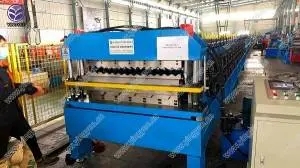
The Evolution of Suspended Ceiling T-Grid Forming Machines
In modern construction and interior design, suspended ceilings have gained significant popularity due to their aesthetic appeal and functionality. At the core of creating these ceilings are suspended ceiling T-grid forming machines, which are designed to produce the T-shaped metal grids that support the ceiling tiles. This article delves into the importance, functionality, and innovations surrounding these machines.
Understanding Suspended Ceilings
A suspended ceiling, also known as a dropped or false ceiling, consists of an overhead system that hangs below the structural ceiling. It serves multiple purposes, including concealing wiring, ductwork, and plumbing, thus enhancing the visual aspect of a space. The T-grid acts as a framework on which lightweight ceiling tiles can be placed, making it crucial for both aesthetics and functional performance.
The Role of T-Grid Forming Machines
T-grid forming machines are essential for manufacturing the metal grid components required for suspended ceilings. These machines use various processes such as roll forming and cutting to produce T-profiles accurately. By utilizing high-quality materials, typically steel or aluminum, manufacturers achieve grids that are not only sturdy but also corrosion-resistant, ensuring longevity.
The manufacturing process involves several steps
1. Roll Forming The process begins with a coil of metal sheet fed into the machine. The machine then shapes the metal into a ‘T’ profile as it passes through a series of rollers.
3. Finishing The formed T-bars may undergo surface treatments such as powder coating, which adds an aesthetic finish while providing additional protection against wear and damage.

4. Quality Control Each batch of T-grids is subjected to rigorous quality checks to ensure they meet industry standards and specifications.
Innovation in T-Grid Manufacturing
With advancements in technology, T-grid forming machines have become more efficient, allowing manufacturers to increase production rates while maintaining high standards of quality. Automation plays a crucial role in this evolution. Modern machines incorporate computerized controls that enhance precision and reduce waste, leading to cost savings in large-scale projects.
Moreover, innovations in materials and designs have expanded the range of T-grids available in the market. Customizable options are now available, allowing designers to select grid styles that complement various architectural finishes, from traditional to contemporary designs.
Another significant trend in T-grid manufacturing is the focus on sustainability. Manufacturers are increasingly using recycled materials and environmentally friendly processes to produce ceiling grids. This shift not only meets the growing demand for sustainable building practices but also appeals to eco-conscious consumers.
Challenges Faced by Manufacturers
Despite the advancements, manufacturers face several challenges. Fluctuating raw material prices can impact production costs, making it essential for companies to negotiate favorable contracts with suppliers. Additionally, the industry experiences intense competition, necessitating continuous innovation to stand out in the market.
Furthermore, as the design needs of architects and contractors become more complex, manufacturers must adapt their processes to accommodate unique specifications. This adaptability requires investment in versatile equipment and skilled labor capable of managing intricate designs while ensuring efficiency.
Conclusion
Suspended ceiling T-grid forming machines are the backbone of the modern construction industry, enabling the production of essential components that enhance both the functionality and aesthetics of interior spaces. As technology continues to advance, and with a growing emphasis on sustainability, these machines are evolving to meet market demands. The future of T-grid manufacturing looks promising, with ongoing innovation and adaptability paving the way for even more refined solutions in the realm of suspended ceilings. Whether for commercial or residential projects, the importance of T-grid forming machines cannot be overstated, as they play a pivotal role in shaping the environments we inhabit.